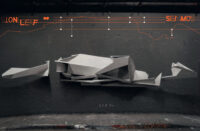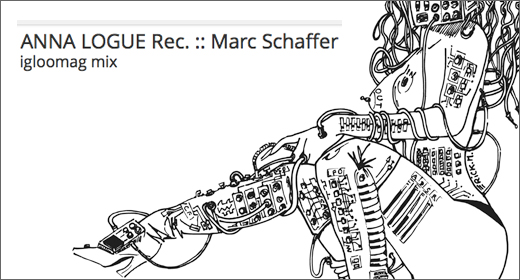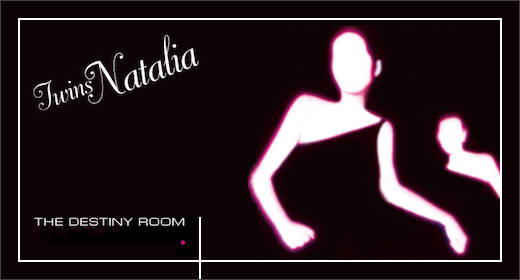Anna Logue released one of the year’s best synth-pop albums in 2014 with Twins Natalia’s spellbinding The Destiny Room and with the late 2015 release of Outside the Night they’ve done it again. If you long to add more retro to your catalog, allow The Silicon Scientist to join the ranks of your favorite artists from the eighties.
It’s been six long years since we last heard from Stefan Bornhorst’s The Silicon Scientist, with 2009’s beautiful, eight track analog synth-pop album Poly that includes—for this reviewer—one of the finest pop songs ever written, “Oceans of Green.” True, there was 2012’s Inselwinter, but that was an entirely instrumental album of material that was originally intended to be his debut.
Now, at last, we have Outside the Night. But do we call this his third album, or his sixth? Bornhorst writes a lot of material whenever he sets out to make a new album, something many a big-name synth pop group has done in the past. But while those big names with lucrative recording deals had the media machine behind them to release these tracks as b-sides or bonus tracks across numerous expensive singles campaigns, The Silicon Scientist was not afforded that luxury.
What we got instead was something that actually felt far more substantial: two entire albums of unique accompanying material in the form of Bookmarks I & II that were released alongside his debut album Windows on the World (also reissued in 2012 in association with Other Voices Records) and sophomore Poly that was every bit as good, though not considered thematically or texturally compatible with them albums themselves.
Things have changed a little this time around. The Silicon Scientist’s third album proper Outside the Night is a staggering one hour and thirty-seven minutes of electro and synth-pop bliss presented by Anna Logue as a typically lavish double LP and 2xCD package. Bornhorst has been busy. Not only that, the physical releases are accompanied by digital copies of a full instrumental version of the album plus the 24-track Timeline 2009 – 2015 featuring exclusive songs that didn’t make it onto the album, alternate mixes and demo versions that take the running time of the entire package up to a staggering five and a half hours!
If you’re already familiar with The Silicon Scientist’s work, you probably think you know what to expect from Outside the Night and you’d not be far wrong. This is The Silicon Scientist on his usual excellent form, with polymoogs, vocoders and a plethora of other analog equipment (check out his Facebook page for images of his studio), and he’s upped the ante even further in terms of production values.
The effervescent but charmingly melancholy “Changes” has to join the pantheon of The Silicon Scientist’s most memorable refrains while “The Longest Day” has shades of Pet Shop Boys’ “Violence” in its soothing, dreamlike drones and warm textures. “Sundial” channels the energy of New Order to blood-pumping, hi-NRG effect, with ecstatic keys and enveloping reverb combining with pre-chorus clatter and crash samples to build across an exhilarating and all-too-short six minutes.
The upbeat, Yazoo-channeling 2012 single “Sinister Street” is included here, beginning in minimal electro mode before adding layer upon layer of synths, reaching a joyous reach-for-rewind, squeaky-clean synthesizer solo crescendo in the final minutes. It’s a shame that “Sights”—the amazing b-side for this track—hasn’t been included in the ‘Timeline 2009 – 2015’ bonus package, but hey, go buy the single and you won’t be disappointed.
Melodically, things go positively ABBA-esque on “Pictures” – minus the creeping sense of kitsch, of course, and one of the brightest stars here is “The Operators,” Bornhorst’s mechanically reclaimed vocals wreathing through a shower of Gershon Kingsley “Popcorn” keys (more of which surface in the simmering heat of the sultry “European Parks in the Rain”) and blossoming firework synth FX. Too short. Extended versions please.
From the outset it’s always been a key component of The Silicon Scientists’s style to hide the vocals under thick layers of vocoder distortion, but whether this is a deliberate stylistic choice or a lack of confidence I don’t know. Either way, it renders the vocals hard to register at times and though more often than not it works well it’d be nice to hear more of Bornhorst’s voice, given how soulful much of his work is.
Although Bornhorst typically likes to allow his songs to unfold in a languorous style across no less than five minutes, it rarely feels that way. He takes his melodies in both oh-so-longed for but also unexpected directions in equal measure, never hesitant to apply subtle or wild variations. In spite of Outside the Night‘s lengthy run time, one still can’t help hoping for extended versions of some of these tracks. See his excellent “Home (Extended Mix)” for a classic example of how and why this works so damn well.
Another reason why Outside the Night is such an expansive opus is Bornhorst’s inclusion of many intermissions and instrumental connecting passages, many featuring solo piano and field recordings. “The Fall (Part 1)” is a particularly moving and dramatic example of these and works beautifully to break up the pop. In truth, however, there are one or two occasions where these asides stall proceedings for just a little too long (“Lighthouse (Part II)” + “Annex i – DX.86”, for example), leaving one impatient for the return of The Silicon Scientist in full-blown vocal electro mode.
The bonus material on Timeline 2009 – 2015 is hard to digest in one sitting, though doubtless it isn’t meant to be, and offers a fascinating insight into the development of Outside the Night. Many of the versions labelled as “demos” or “rough mixes” are so good you’d never think of them as such, often harkening back to The Silicon Scientist’s earlier production styles. You might even find yourself preferring some of these versions.
Of the outtake tracks, “Motion” has an early, minimal and industrial Depeche Mode feel to it at times. It’s fun, but wouldn’t have worked in the context of the album as a whole. The motorik “Silver_03” fuses Kraftwerk with Yazoo-era Vince Clarke, but perhaps the finest of the three is the lush and luxurious, swirling “Systems”, which recalls many of the finest moments on the Bookmarks II album.
Anna Logue released one of the year’s best synth-pop albums in 2014 with Twins Natalia’s spellbinding The Destiny Room and with the late 2015 release of Outside the Night they’ve done it again. If you long to add more retro to your catalog, allow The Silicon Scientist to join the ranks of your favorite artists from the eighties. You won’t regret it. Promise.
Outside the Night is available on Anna Logue.
























